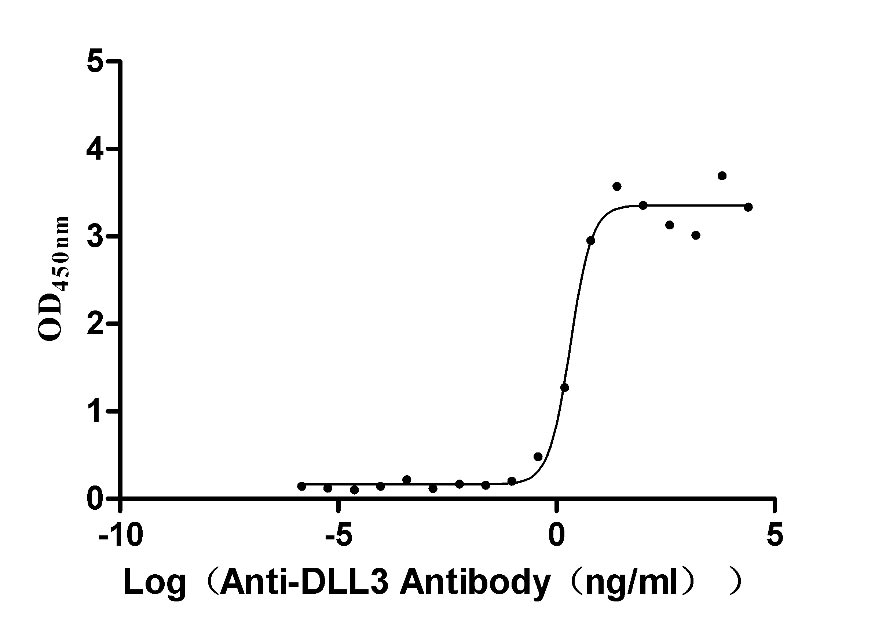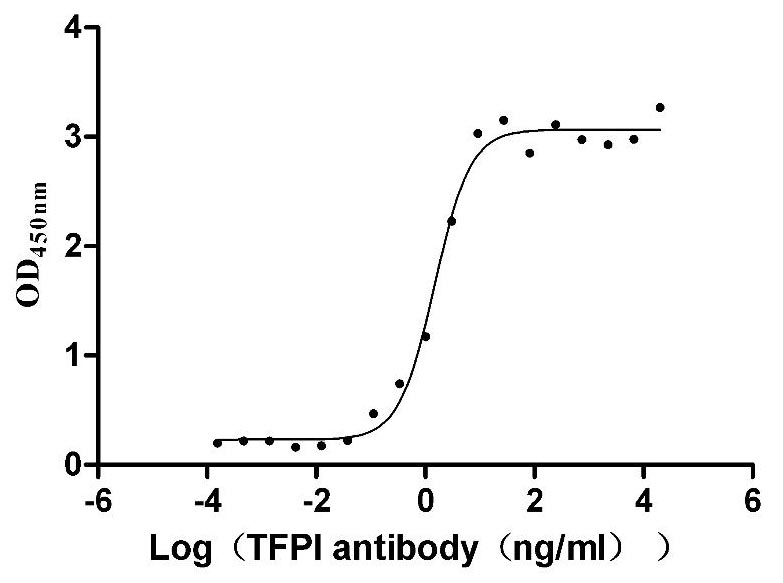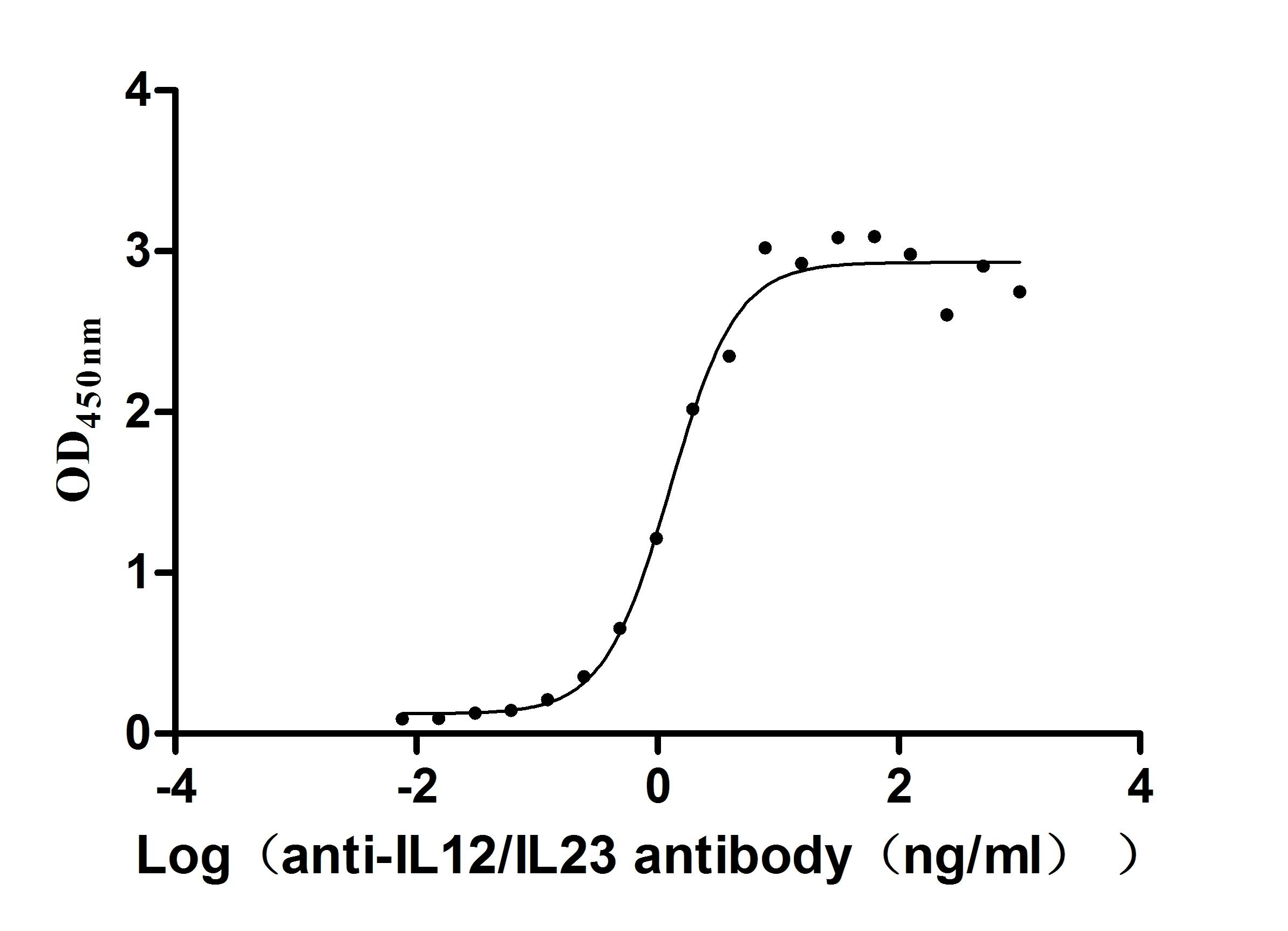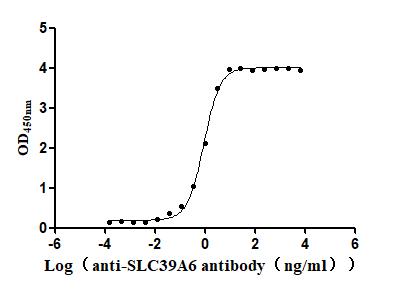Recombinant Human Progesterone receptor (PGR NR3C3)
-
中文名稱:
-
貨號(hào):CSB-YP1138HU
-
規(guī)格:
-
來(lái)源:Yeast
-
其他:
-
中文名稱:
-
貨號(hào):CSB-EP1138HU
-
規(guī)格:
-
來(lái)源:E.coli
-
其他:
-
中文名稱:
-
貨號(hào):CSB-EP1138HU-B
-
規(guī)格:
-
來(lái)源:E.coli
-
共軛:Avi-tag Biotinylated
E. coli biotin ligase (BirA) is highly specific in covalently attaching biotin to the 15 amino acid AviTag peptide. This recombinant protein was biotinylated in vivo by AviTag-BirA technology, which method is BriA catalyzes amide linkage between the biotin and the specific lysine of the AviTag.
-
其他:
-
中文名稱:
-
貨號(hào):CSB-BP1138HU
-
規(guī)格:
-
來(lái)源:Baculovirus
-
其他:
-
中文名稱:
-
貨號(hào):CSB-MP1138HU
-
規(guī)格:
-
來(lái)源:Mammalian cell
-
其他:
產(chǎn)品詳情
-
純度:>85% (SDS-PAGE)
-
基因名:PRGR
-
Uniprot No.:
-
別名:Progesterone receptor; PR; Nuclear receptor subfamily 3 group C member 3; PGR NR3C3
-
種屬:Homo sapiens (Human)
-
蛋白標(biāo)簽:Tag?type?will?be?determined?during?the?manufacturing?process.
The tag type will be determined during production process. If you have specified tag type, please tell us and we will develop the specified tag preferentially. -
產(chǎn)品提供形式:Liquid or Lyophilized powder
Note: We will preferentially ship the format that we have in stock, however, if you have any special requirement for the format, please remark your requirement when placing the order, we will prepare according to your demand. -
復(fù)溶:We recommend that this vial be briefly centrifuged prior to opening to bring the contents to the bottom. Please reconstitute protein in deionized sterile water to a concentration of 0.1-1.0 mg/mL.We recommend to add 5-50% of glycerol (final concentration) and aliquot for long-term storage at -20℃/-80℃. Our default final concentration of glycerol is 50%. Customers could use it as reference.
-
儲(chǔ)存條件:Store at -20°C/-80°C upon receipt, aliquoting is necessary for mutiple use. Avoid repeated freeze-thaw cycles.
-
保質(zhì)期:The shelf life is related to many factors, storage state, buffer ingredients, storage temperature and the stability of the protein itself.
Generally, the shelf life of liquid form is 6 months at -20°C/-80°C. The shelf life of lyophilized form is 12 months at -20°C/-80°C. -
貨期:Delivery time may differ from different purchasing way or location, please kindly consult your local distributors for specific delivery time.Note: All of our proteins are default shipped with normal blue ice packs, if you request to ship with dry ice, please communicate with us in advance and extra fees will be charged.
-
注意事項(xiàng):Repeated freezing and thawing is not recommended. Store working aliquots at 4°C for up to one week.
-
Datasheet :Please contact us to get it.
相關(guān)產(chǎn)品
靶點(diǎn)詳情
-
功能:The steroid hormones and their receptors are involved in the regulation of eukaryotic gene expression and affect cellular proliferation and differentiation in target tissues. Depending on the isoform, progesterone receptor functions as transcriptional activator or repressor.; Ligand-dependent transdominant repressor of steroid hormone receptor transcriptional activity including repression of its isoform B, MR and ER. Transrepressional activity may involve recruitment of corepressor NCOR2.; Transcriptional activator of several progesteron-dependent promoters in a variety of cell types. Involved in activation of SRC-dependent MAPK signaling on hormone stimulation.; Increases mitochondrial membrane potential and cellular respiration upon stimulation by progesterone.
-
基因功能參考文獻(xiàn):
- We found that the Alu insertion was associated with breast cancer incidence in Indians and Indo-European mixed racial groups, but the association disappeared for patients of Caucasian or Latino decent. Our meta-analysis showed that the Alu-insertion progesterone receptor gene polymorphism was not associated with breast cancer. [Meta-analysis] PMID: 29370776
- findings showed no association between PROGINS and leiomyoma in the overall analysis nor in either of the subgroups, Asian or non-Asian, in all genetic models;. conclusion: The PROGINS polymorphisms cannot be considered a risk factor for developing uterine leiomyoma - Systematic Review and Meta-Analysis PMID: 29630404
- in primary breast tumors, PR-A expression was correlated negatively with miR-92a-3p expression and positively with miR-26b-5p expression. Therefore, hormonal cross-talk of PR-A with ER is probably a fundamental mechanism that enables metastasis of luminal breast cancer. PMID: 29162724
- heterogeneous distribution in deep infiltrating endometriosis PMID: 29383962
- This study aimed to determine the presence and localization of oestrogen receptors (ERs), progesterone receptors (PRs), and androgen receptors (ARs) in both healthy and varicose vein wall cells and their relationship with gender. PMID: 30250632
- These findings suggest that in myometrial cells the repressive activity of PR-A on PR-B increases with advancing gestation and is induced by pro-inflammatory cytokines. PMID: 28671036
- polymorphisms do not predict in vitro fertilization outcome PMID: 29916276
- Data show that insulin-like growth factor-II mRNA-binding protein 2 and 3 (IMP2/3)-miR-200a-progesterone receptor axis represents a double-negative feedback loop and serves as a new potential therapeutic target for the treatment of Triple-negative breast cancer (TNBC). PMID: 29217458
- The experimental data corroborated the inhibitory function of miR-513a-5p on progesterone receptor expression in breast cancer confirming that progesterone receptor is a target of miR-513a-5p PMID: 29126102
- A major finding of our study is that one out of five (20%) patients with breast cancer BM had a receptor discrepancy between the primary tumor and the subsequent BM, with loss of hormone receptors (ER and/or PR) expression, and gain of HER2 overexpression as the most commonly observed changes PMID: 28975433
- Single nucleotide polymorphism in progesterone receptor gene is associated with the risk of type 2 diabetes among Hispanic Americans compared to European American postmenopausal women. PMID: 29417738
- In progesterone control of myometrial contractility during pregnancy and labour, while liganded nuclear progesterone receptor B can suppress the expression of Cx43, unliganded progesterone receptor A paradoxically translocates to the nucleus where it acts as a transcriptional activator of this labour gene. PMID: 27220952
- Progesterone receptor, EGFR, and galectin-3 are expressed differentially in uterine smooth muscle tumors. PMID: 29729689
- Estrogen receptor (ER) and progesterone receptor (PR) expression in endometrial carcinoma (EC) were significantly higher than those in the paracarcinoma tissue and control. PMID: 29081408
- Alcohol consumption may have differential effects on concordant and discordant receptor subtypes of breast cancer. PMID: 29353824
- General obesity, indicated by BMI, is more strongly associated with ER+/PR+ subtype, especially among premenopausal women, whereas central obesity, indicated by WHR, is more specific for ER-/PR- subtype, independent of menopausal status. These results suggest that different chemoprevention strategies may be appropriate in selected individuals. PMID: 28912152
- TIMP-3 mRNA expression levels positively correlates with levels of miR-21 in in situ breast carcinomas and negatively in progesterone receptor positive invasive breast carcinomas. PMID: 28935174
- results suggest differential downstream progesterone receptor signalling, as progesterone receptor regulates MMP3/10 expression via HIF1A, which is not involved in ADAMTS-1 expression PMID: 28736153
- Association of progesterone receptor gene polymorphism with threatened abortion. PMID: 29762972
- Villin, Pro-Ex-C and progesterone/estrogen receptor expression have diagnostic and predictive roles in endocervical and endometrioid adenocarcinoma. PMID: 28832070
- These data collectively indicate that progesterone suppresses triple-negative breast cancer (TNBC) growth and metastasis via mPRalpha, which provides evidence of the anti-neoplastic effects of progesterone-mPRalpha pathway in the treatment of human TNBC. PMID: 28713912
- Patients with Estrogen- and progesterone receptors-positive invasive lobular carcinoma (ILC) and invasive ductal carcinoma (IDC)have similar quantitative ER and PR expression profiles, implicating that ER/PR expression is unlikely to be a confounding factor in studies concerning chemo-sensitivity of ILC and IDC PMID: 28365834
- The progesterone receptor B (PRB) and androgen Receptor (AR) mRNA levels were highest in tumors. PMID: 29491078
- Chorionic gonadotropin activates Epac-Erk1/Erk2 signaling regulating progesterone receptor expression and function in human endometrial stromal cells. PMID: 28333280
- Ten international pathology institutions participated in this study and determined messenger RNA expression levels of ERBB2, ESR1, PGR, and MKI67 in both centrally and locally extracted RNA from formalin-fixed, paraffin-embedded breast cancer specimens with the MammaTyper(R) test. Samples were measured repeatedly on different days within the local laboratories, and reproducibility was assessed by means of variance comp... PMID: 28490348
- Human myometrial tissue in culture undergoes changes in progesterone receptor (PR) gene expression consistent with transition toward a laboring phenotype. TSA maintained the nonlaboring PR isoform expression pattern. PMID: 28540297
- OHPg/PR-B through Beclin-1 and Bcl2 evoke autophagy-senescence transition in breast cancer cells PMID: 27462784
- Report a significant survival benefit in lung adenocarcinoma patients with positive expression of one of the investigated hormonal receptors: androgen receptor, estrogen receptor-alpha or progesterone receptor. PMID: 27690341
- We investigate the impact of central histology (n = 772), immunohistochemistry for intrinsic subtyping and IHC4, and dichotomous (GG) or continuous (GGI) genomic grade (n = 472) on patient outcome and benefit from taxane chemotherapy, focusing on HR+/HER2(HR: ER and/or PR)- patients (n = 459) PMID: 27022068
- progesterone receptor expression status correlates with final pregnancy outcome PMID: 27728856
- RA induced loss of PR binding only at the proximal site. Interestingly, RARalpha was recruited to the -1.1 kb PRE and the -130 bp PRE/RARE regions with P4, but not RA alone or RA plus P4 PMID: 28692043
- the 5alpha-reduction of progesterone decreased PR activation significantly, 16alpha-hydroxyprogesterone and 16OH-dihydroprogesterone exhibited comparable receptor activation. PMID: 27664517
- C/EBPbeta negatively regulates PR-B expression in glioblastoma cells. PMID: 27663075
- Evaluation of progesterone expression in axillary lymph node metastasis of ER-positive, HER2-negative breast cancer may enable prediction of patients who are less likely to benefit from adjuvant tamoxifen. PMID: 28416639
- Insight into previously reported associations between +331G/A polymorphism and breast cancer risk. [meta-analysis; review] PMID: 29084518
- findings suggest that GATAD2B serves as an important mediator of progesterone-progesterone receptor suppression of proinflammatory and contractile genes during pregnancy; decreased GATAD2B expression near term may contribute to the decline in progesterone receptor function, leading to labor PMID: 28576827
- The altered expression of ER and PR may be associated with the expression variation of integrin and pinopode formation in endometrium of luteal phase deficit women. PMID: 27960568
- We sought to determine the relation between 17-alpha hydroxyprogesterone caproate plasma concentrations, progesterone receptor single nucleotide polymorphisms and single nucleotide polymorphisms in CYP3A4 and CYP3A5 and spontaneous preterm birth. PMID: 28522317
- the estrogen- (ER), progesterone- (PgR) and HER2/neu receptor status of the primary tumor with brain metastases in a series of 24 consecutive breast cancer patients, is reported. PMID: 28870906
- we found that combinatorial MK-2206+progesterone treatments decreased angiogenesis and proliferation in the Pten(d/d) conditional mouse model of endometrial cancer. Taken together, these findings suggest that a combinatorial therapeutic approach utilizing Akt inhibitors with progestins may improve the efficacy of progestin therapy for the treatment of endometrial cancer. PMID: 26996671
- The interplay between intracellular progesterone receptor and PRKCA-PRKCD plays a key role in migration and invasion of human glioblastoma cells. PMID: 27717886
- Folic acid inhibits colon cancer cell proliferation through activation of PR. PMID: 27233474
- The endometrial expression of PR and Ki67 along with serum CA125 predicted the development of lymph node metastasis in endometrial cancer. PMID: 27163153
- Overexpression of RNA-binding region-containing protein 1 (RNPC1) increased, whereas knockdown of RNPC1 decreased, the level of progesterone receptor (PR) protein and transcripts. PMID: 27634883
- analysis of pancreatic adenocarcinoma reveals nPR and the presence of mPR of alpha, beta, gamma subtypes both at the mRNA and protein levels PMID: 27449817
- Working model. During most of pregnancy, progesterone via PR-B promotes myometrial cell quiescence in part by repressing responsiveness to proinflammatory stimuli. With advancing gestation, prolabor signals increase the inflammatory load on the uterus until a threshold is reached. The threshold is the point at which inflammatory stimuli augment PR-A stability. PMID: 27886516
- Choroidal metastases from BC are associated with ER and PR expression in the primary tumor and the luminal B molecular subtype. PMID: 27479811
- Data suggest the relevance of determining the progesterone receptor (PR) isoform ratio before starting antiprogestin treatments. PMID: 28376177
- The data show that human parturition involves the phosphorylation of PR-A at serine-345 in myometrial cells and that this process is ligand dependent and induced by a proinflammatory stimulus. PMID: 27653036
- PR-B expression was significantly reduced in the eutopic endometrium (p=0.031) and ovarian endometrioma (p=0.036) from women with advanced-stage endometriosis compared with eutopic endometrium tissues from control subjects. PMID: 27593876
顯示更多
收起更多
-
亞細(xì)胞定位:Nucleus. Cytoplasm. Note=Nucleoplasmic shuttling is both hormone- and cell cycle-dependent. On hormone stimulation, retained in the cytoplasm in the G(1) and G(2)/M phases.; [Isoform A]: Nucleus. Cytoplasm. Note=Mainly nuclear.; [Isoform 4]: Mitochondrion outer membrane.
-
蛋白家族:Nuclear hormone receptor family, NR3 subfamily
-
組織特異性:In reproductive tissues the expression of isoform A and isoform B varies as a consequence of developmental and hormonal status. Isoform A and isoform B are expressed in comparable levels in uterine glandular epithelium during the proliferative phase of th
-
數(shù)據(jù)庫(kù)鏈接:
Most popular with customers
-
Recombinant Macaca fascicularis Delta-like protein 3 (DLL3), partial (Active)
Express system: Mammalian cell
Species: Macaca fascicularis (Crab-eating macaque) (Cynomolgus monkey)
-
Recombinant Human Tissue factor pathway inhibitor (TFPI), partial (Active)
Express system: Mammalian cell
Species: Homo sapiens (Human)
-
Recombinant Human IL12B&IL12A Heterodimer Protein (Active)
Express system: Mammalian cell
Species: Homo sapiens (Human)
-
Recombinant Human Interleukin-17A (IL17A) (T26A) (Active)
Express system: Baculovirus
Species: Homo sapiens (Human)
-
Recombinant Macaca fascicularis Zinc transporter ZIP6 isoform X1(SLC39A6),partial (Active)
Express system: Baculovirus
Species: Macaca fascicularis (Crab-eating macaque) (Cynomolgus monkey)
-
Recombinant Human Interleukin-1 receptor accessory protein (IL1RAP), partial (Active)
Express system: Mammalian cell
Species: Homo sapiens (Human)





-AC1.jpg)











